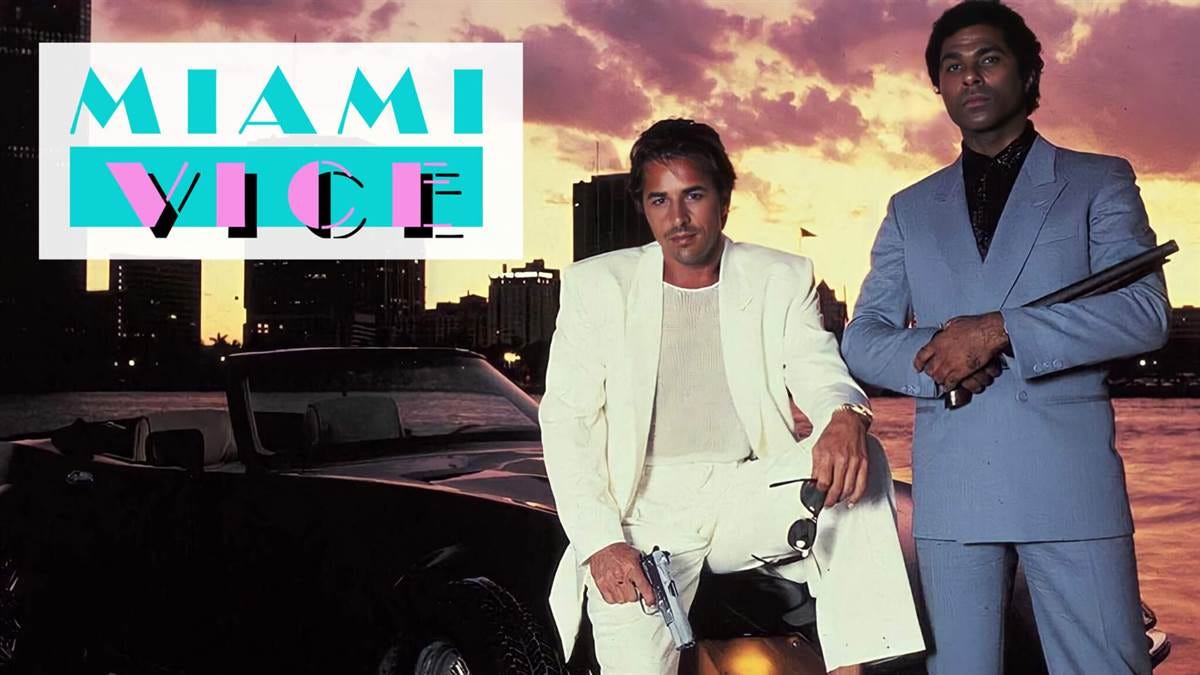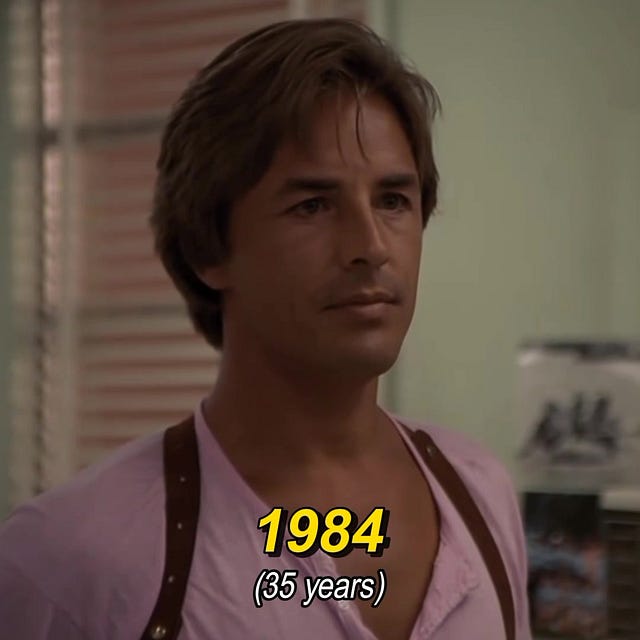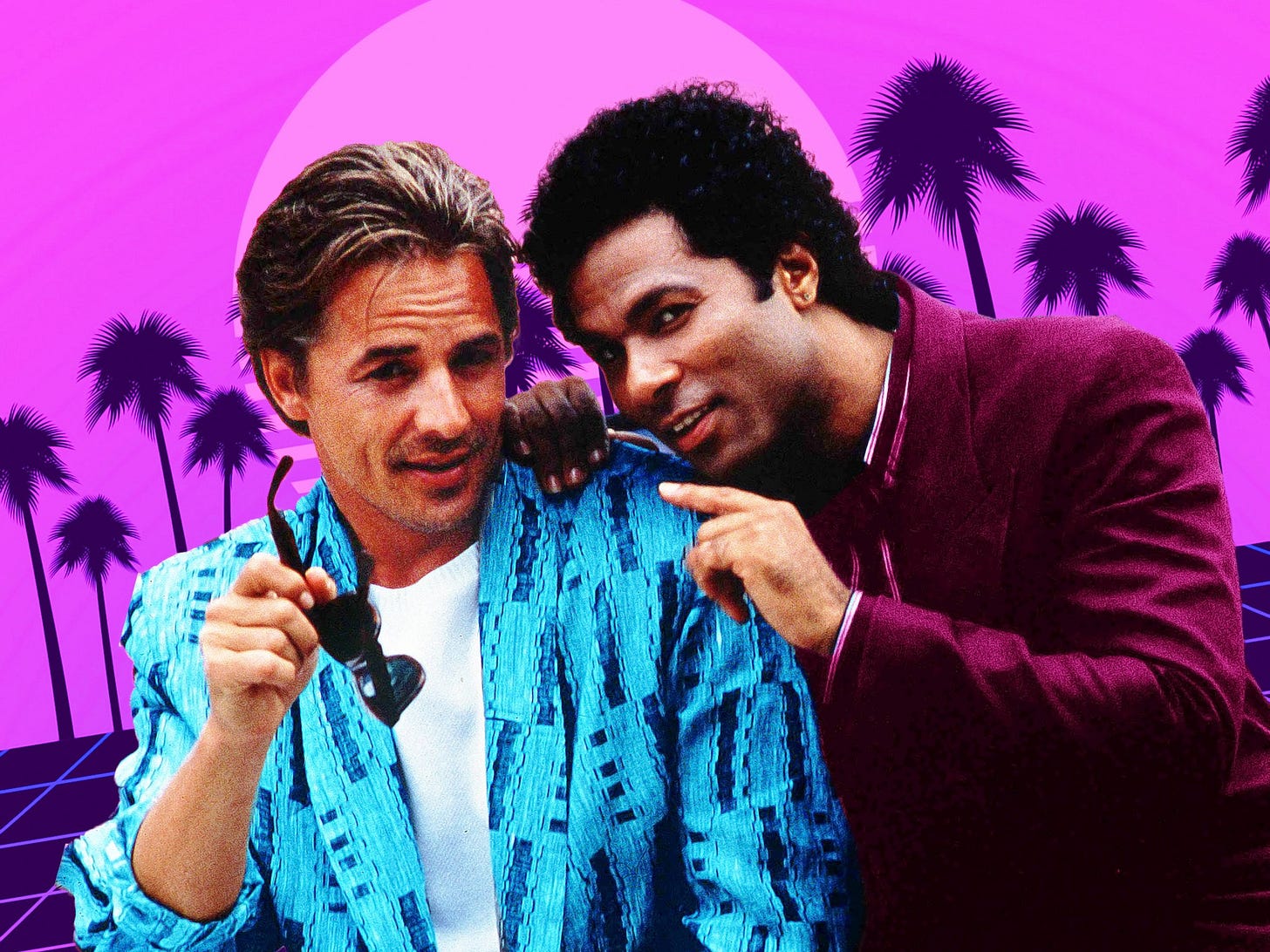This Is Not a Reboot: Miami Vice in the Open Garden — Neon, Heat, and Total Creative Chaos
A friend of mine recently asked me a deceptively simple question. He created one of the most iconic shows in the history of television—global, era-defining, endlessly referenced. A legacy platform is trying to reboot it. They’re already deep in development, but the rights are about to revert.
He turned to me and said: “What would you do with a legacy brand right now—in the open garden?"
Can’t say what the show is. But lets just say he’s an iconoclast who did it his way and broke the mold on how TV shows are made.
So to keep things anonymous let’s use another example. One that still packs cultural weight. One that’s sexy, pastel-drenched, and full of possibility.
Let’s talk about Miami Vice.
When I was in high school, Miami Vice was the biggest thing on TV. The world stopped when it aired. Its style. Its tone. Its boldness. There was nothing like it.
But today? Maybe if you’re over 50, you remember. If not, maybe you saw the Colin Farrell /Jamie Foxx movie. Maybe if you’re over 35…
But the nostalgia still hits. The DNA still resonates. The question is: how do you bring it back—not just as content, but as culture?
Let’s break it down.
PHASE I: Reignite the Nostalgia Core
Goal: Bring back the die-hards and remind the culture why this mattered.
Legacy IP is a reservoir of emotion—but only if you know how to tap it. This phase is about memory, not marketing. You start not with plot or characters, but with tone, texture, and the emotional flashpoint that made the brand unforgettable.
 Tiktok failed to load.
Tiktok failed to load.Enable 3rd party cookies or use another browser
1. Short form Aesthetic Blitz
Begin by flooding TikTok, Reels, and Shorts with a series of short form content that hits like a lightning bolt of memory. You bring back the white Ferraris, the neon sunsets, the boats slicing through moonlight. But you don’t just rehash—you remix. Pair those images with trap beats, with reggaetón, with modern editing rhythms and text overlays that say things like: “This was your dad’s favorite show. Now it’s yours.”
Don’t explain the show. Let people feel it again.
2. Vice: The Original Heat (Podcast)
This is where the past speaks directly to the present. The podcast is hosted by Don Johnson and his daughter Dakota Johnson, who wasn’t even born when the original aired. That dynamic is the handoff—father to daughter, legacy to future.
Don brings the behind-the-scenes stories, the original heat. Dakota brings curiosity, taste, and a bridge to the generation that will define what Vice becomes next. Together, they explore everything from the show’s cultural influence to its aesthetic legacy. They talk to fashion designers influenced by the show's wardrobe, musicians who trace synth wave’s rise back to Jan Hammer, and contemporary voices interrogating how masculinity, race, and swagger have evolved since the Reagan era.
This isn’t a look back. It’s a conversation across time, led by the man who defined the original and the woman who now helps pass the baton.
3. The Real Miami Vice (Docu-Crime Series)
You pivot from fiction to fact, with a serialized podcast or YouTube docu-series that tells the real story behind the myth. Not a reboot, but a reconstruction. Cocaine cowboys. Undercover stings. Corrupt cops. The rise of Miami as a global narco hub in the ‘80s. You call it The Real Miami Vice and use Vice-style aesthetics—grainy recreations, synth-backed narratives—to draw the line between truth and the fiction it inspired. It’s The Last Narc meets Slow Burn with pastel blood.
4. Digital Archive Drop: @MiamiViceArchive
At the same time, you launch a social feed—part museum, part fan service—dedicated to preserving the deep cuts. Behind-the-scenes photos. Costume pieces. Prop closeups. But you don’t just post the past—you mirror it against the now. Crockett’s linen blazer gets placed next to a Fear of God drop. Tubbs’s loafers sit beside Bad Bunny’s stage fit. It’s nostalgia recast as cultural currency.
5. VICEWORLD: Traveling Pop-Up
Then you take it to the streets. VICEWORLD is a traveling experience that lands in places like Miami, LA, Mexico City, and Tokyo—not with a Comic-Con booth, but with something that feels more like an underground rave. Rebuilt sets. Replica cars. Interactive stations where fans can remix their own Vice title sequence with modern music and their own footage. DJs spinning Jan Hammer remixes inside fog-drenched clubs. A physical immersion into the aesthetic that feels too cool to be corporate—and too fun not to attend.
PHASE II: Remix for a New Generation (and Capture Everything)
Goal: Translate the DNA into new media and creators—while building a data engine beneath it all.
Now the brand becomes elastic. You let new creators stretch it, reframe it, and—most importantly—make it theirs. And while that’s happening, you’re quietly building the infrastructure to understand who’s leaning in and why.
1. #ViceRemixChallenge
You throw open the doors to every filmmaker, TikToker, musician, and stylist who’s been waiting for this moment. You give them scenes. You give them stems. You let them remix. Neon noir short films. Synth-scored fashion edits. Alt trailers. It’s all fair game. The best entries aren’t just celebrated—they’re folded into the brand’s forward momentum. You don’t ask permission. You invite collaboration.
2. Fan Creator Microgrants: Vice Is Everywhere
Now you go global. You identify 20 to 30 independent creators in cities across the world—São Paulo, Manila, Lagos, Tokyo—and fund them to make their own Vice story. Some will make zines. Some will make music videos. Others might write short graphic novels or documentary essays. You give them $2K–$10K, repost support, and total creative freedom. And you let Miami Vice transform into something bigger than Miami.
3. Always Be Collecting
And while all this is happening, you are building the single most valuable asset of the reboot: a CRM. Every remix. Every RSVP. Every fan comment. You’re collecting emails. Phone numbers. Behavioral insights. Engagement signals. Not just for marketing—but for feedback. For development. For story. It’s not just data. It’s your creative radar.
PHASE III: Activate the Community to Build the Show
Goal: Use fan data + creator talent to bake the community into the production itself.
You don’t go dark while the show is in development. You go louder. You turn the audience into co-conspirators.
1. TikTok Casting Campaign: #ViceYourself
One of the show’s leads gets cast in public. You invite creators to audition in character—crypto bros, undercover influencers, nightclub informants. The CRM already knows who your superfans are. Now they become your casting scouts. It’s democratic, it’s entertaining, and it generates a built-in audience before a single frame is shot.
2. Bring Your Best Creators Inside
The creators who shaped the remix phase—those who understood the tone, reimagined the world, and sparked real cultural momentum—get invited to the table. But they’re not alone. Don Johnson joins as an executive producer on the series, helping guide the tone, voice, and character of the new Miami Vice.
This isn’t a vanity credit. Don is deeply involved—reviewing footage, weighing in on casting, shaping story arcs, and collaborating with the most engaged creators and superfans. His original instincts help anchor the show’s authenticity, while the new generation pushes the brand forward. It’s a partnership between lived experience and lived-in fandom.
3. Charli XCX Scores It—Live
You want someone like Charli XCX doing the music? Great. But don’t just drop a soundtrack. Stream the making of it. Let fans watch her score the scenes live, build the themes in real-time, argue with producers over synth patches. You’re not just releasing music—you’re dropping serialized intimacy with the creative process.
4. Deep Access, Real Time
And you don’t stop at the actors. You take the camera backstage—and backstage of backstage. You bring in the on-set DEA consultants, the prop stylists, the set designers. You stream their process. Interview them. Let them explain how one small detail in a nightclub scene is actually based on a real-life bust from 1986. You let the audience fall in love with the bones of the show, not just the skin.
5. Premieres with Superfans
When it’s time to launch, you don’t throw a party for executives. You throw premiere events in the cities where your community already lives—Miami, São Paulo, Tokyo, LA. You invite the remixers. The TikTok stars. The fan artists. The ones who’ve been in this story from the beginning. Don Johnson shows up too—standing shoulder to shoulder with the people who helped reimagine the thing he once defined. The content from those nights becomes your trailer. Your social proof. Your movement.
6. Fashion Tie-Ins That Matter
You wrap the cultural loop with a fashion collaboration—not merch, but a full-on capsule line. Designed with a label that understands how to bend nostalgia into modern cool. Aimé Leon Dore. Martine Rose. Kith. Blazers, boots, pastel pieces tied directly to plot points and character arcs. It’s not brand-building. It’s world-building through wardrobe.
And Then… You Drop the Show
By the time the premiere hits, it doesn’t feel like a launch. It feels like a cultural event that’s been underway for two years.
The audience isn’t discovering the show—they’ve helped build it. They’ve cast it. Scored it. Dressed it. They’ve remixed the theme music, turned their bedrooms into Crockett mood boards, and showed up at the underground premieres. Don Johnson is back—not just in the credits, but in the room, guiding the evolution. Dakota Johnson is here too, bridging past and future in real time.
And here’s the part no legacy media company wants to hear:
They’ll risk millions on a writers’ room. Maybe even a pilot. Sometimes an entire season. But ask them to put that same budget into building the audience first—into content, culture, and community—and they’ll hesitate.
But that’s the real bet. You build the audience before you build the story. You find your super fan before you find your subplot. You light the fire and then bring in the writers to shape the smoke. And all the while, you’re monetizing—through YouTube content, podcast ads, fashion drops, experiential tickets, and licensing.
By the time the writers’ room meets, the audience isn’t just waiting.
They’re already watching.
And the show? The show doesn’t start the engine…
It just makes the flywheel spin faster.







What a fantastic and thought provoking piece that was. Ben O'Dell seems to be a brilliant mind with a entrepreneur's heart who is extremely comfortable within the "chaos" that we are all experiencing right now. And when there is chaos, the entrepreneur will emerge to find a way to bring their creative dreams to the world. It is an evolution that other businessmen will copy - then drag the decision making executives (buyers) into line. OR, those buyers will find themselves replaced. This is the way that chaos becomes mainstream... and on we go... Well done Mr. O'Dell, I am now a fan.
Genius. Nothing else to say honestly.